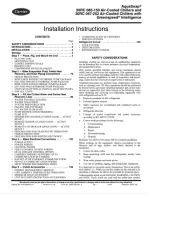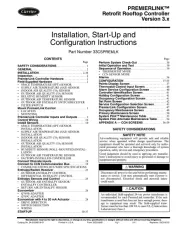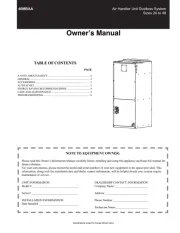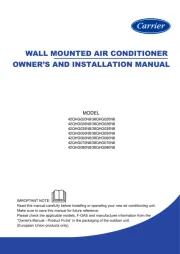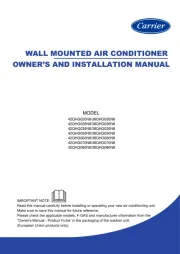
Manufacturer reserves the right to discontinue, or change at any time, specifications or designs without notice and without incurring obligations.
Catalog No. 04-53300224-01 Printed in U.S.A. Form 30XV-17SI Pg 1 12-21 Replaces: 30XV-11SI
Installation Instructions
CONTENTS
Page
SAFETY CONSIDERATIONS . . . . . . . . . . . . . . . . . . . 1
INTRODUCTION . . . . . . . . . . . . . . . . . . . . . . . . . . . . . . 3
INSTALLATION . . . . . . . . . . . . . . . . . . . . . . . . . . . . . . 3
Storage . . . . . . . . . . . . . . . . . . . . . . . . . . . . . . . . . . . . . 3
Step 1 — Inspect Shipment . . . . . . . . . . . . . . . . . . . . 3
Step 2 — Place, Mount, and Rig the Unit . . . . . . . . . 3
• PL
ACING UNIT
• MOUNTING UNIT
• EXPORT SHIPPING RAILS
• RIGGING UNIT
Step 3 — Make Refrigerant, Evaporator Fluid and
Drain Piping Connections . . . . . . . . . . . . . . . . . . 97
• SPLIT UNIT ASSEMBLY
• GENERAL
• EVAPORATOR PUMP CONTROL
• PREPARATION FOR YEAR-ROUND OPERATION
Step 4 — Fill the Chilled Water Loop . . . . . . . . . . 108
• BRINE EVAPORATOR OPTION
• WATER SYSTEM CLEANING
• WATER TREATMENT
• SYSTEM PRESSURIZATION
• FILLING THE SYSTEM
• SET WATER FLOW RATE
• FREEZE PROTECTION
• PREPARATION FOR WINTER SHUTDOWN
Step 5 — Make Electrical Connections . . . . . . . . . 110
• POWER SUPPLY
• FIELD POWER CONNECTIONS
• POWER WIRING
• FIELD CONTROL POWER CONNECTIONS
• CCN COMMUNICATION BUS WIRING
• BACNET IP OR ETHERNET COMMUNICATION
• NON-CCN COMMUNICATION WIRING
• FIELD CONTROL OPTION WIRING
• DUAL CHILLER LEAVING WATER SENSOR
Step 6 — Install Accessories . . . . . . . . . . . . . . . . . 166
• ENERGY MANAGEMENT MODULE
• UNIT SECURITY/PROTECTION ACCESSORIES
• COMMUNICATION ACCESSORIES
• SERVICE OPTIONS
Step 7 — Leak Test Unit . . . . . . . . . . . . . . . . . . . . . 167
• DE
HYDRATION
• REFRIGERANT CHARGE
SAFETY CONSIDERATIONS
Installation and servicing of air-conditioning equipment can be
hazardous due to system pressure and electrical components. Only
trained and qualified service personnel should install, repair, or
service air-conditioning equipment.
Untrained personnel can perform basic maintenance functions of
cleaning coils and filters and replacing filters. All other operations
should be performed by trained service personnel. When working
on air-conditioning equipment, observe precautions in the
literature, tags and labels attached to the unit, and other safety
precautions that may apply.
Follow all safety codes. Wear safety glasses and work gloves. Use
quenching cloth for unbrazing operations. Have fire extinguisher
available for all brazing operations.
It is important to recognize safety information. This is the safety-
alert symbol . When you see this symbol on the unit and in
instructions or manuals, be alert to the potential for personal
injury.
Understand the signal words DANGER, WARNING, CAUTION,
and NOTE. These words are used with the safety-alert symbol.
DANGER identifies the most serious hazards which will result in
severe personal injury or death. WARNING signifies hazards
which could result in personal injury or death. CAUTION is used
to identify unsafe practices, which may result in minor personal
injury or product and property damage. NOTE is used to highlight
suggestions which will result in enhanced installation, reliability,
or operation.
WARNING
Electrical shock can cause personal injury and death. Shut off
all power to this equipment during installation. There may be
more than one disconnect switch. Tag all disconnect locations
to alert others not to restore power until work is completed.
WARNING
Electrical shock can cause personal injury and death. After unit
power is disconnected, wait at least 20 minutes for the VFD
(variable frequency drive) capacitors to discharge before open-
ing drive.
WARNING
DO NOT VENT refrigerant relief valves within a building.
Outlet from relief valves must be vented in accordance with
the latest edition of ANSI/ASHRAE (American National Stan-
dards Institute/American Society of Heating, Refrigerating and
Air-Conditioning Engineers) 15 (Safety Code for Mechanical
Refrigeration). The accumulation of refrigerant in an enclosed
space can displace oxygen and cause asphyxiation. Provide ad-
equate ventilation in enclosed or low overhead areas. Inhala-
tion of high concentrations of vapor is harmful and may cause
heart irregularities, unconsciousness or death. Misuse can be
fatal. Vapor is heavier than air and reduces the amount of oxy-
gen available for breathing. Product causes eye and skin irrita-
tion. Decomposition products are hazardous.
AquaForce
®
30XV140-500, Series B
Variable Speed Air-Cooled Liquid Chillers
with Greenspeed
®
Intelligence


